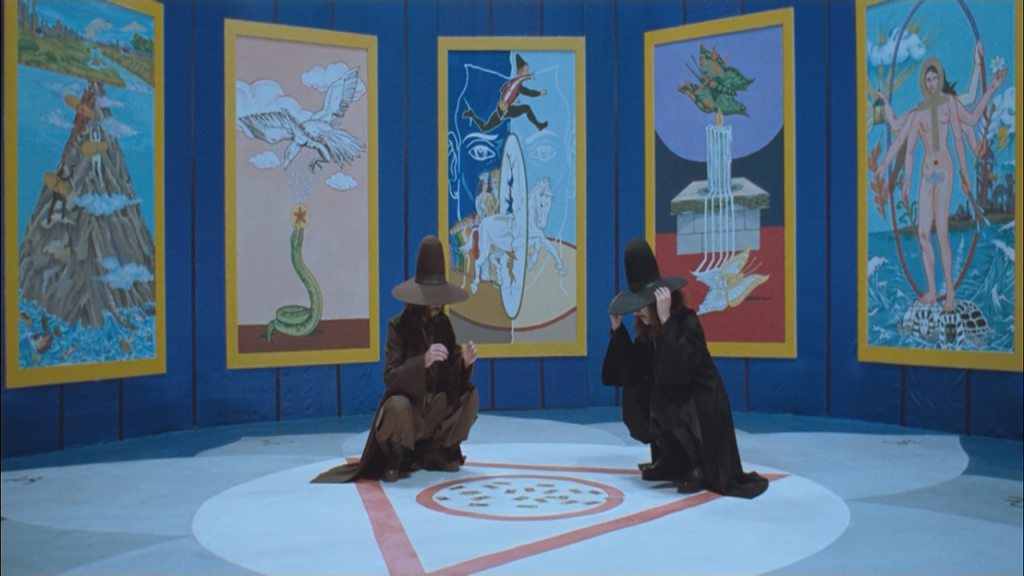
The Holy Mountain (1973; Alejandro Jodorowsky)
GRADE: A-
By Daniel Barnes
Where do you even begin to penetrate something as insane, and insanely inventive, as Jodorowsky’s psychedelic religious parable? Here is the plot synopsis offered by IMDB: “This film gives the omniscient view of what social engineering caused by greed has done to the modern world, but shows us how to live and not give in to a material world.”
OK. That’s certainly one to way look at it. Perhaps we can turn to my notes for another perspective: “bottles, bugs, piss stream, naked boys w/ fig leaves, flower palm, stigmata, piles of bodies, crucified dogs on parade, sophisticated camerawork, cops kill students, nightmare satire, birds from open wounds, tourist raped.” That covers about 90 seconds of screen time.
Maybe The Holy Mountain is just about assembling a restless montage of fucked-up shit, taking us on an acid trip through the poison-tipped nettles of Jodorowsky’s subconscious. There is a stream-of-consciousness feel to the pace and structure, and most of the film defies a simple reading. My perspective is that The Holy Mountain is less a film about Christ than about Christianity, with Jodorowsky leading us through an avant-garde spook house of the depraved effects of religious fundamentalism before finally showing us a way out. The way out happens to involve burning idols and money, expanding consciousness through the use of psychedelic drugs, and participating in cultish, est-like self-help rituals. Look, it was the early 1970s, alright?
The best precedent I can think of for The Holy Mountain is Bunuel’s 1929 silent classic L’Age d’Or, which closed with a shot of a crucifix draped in scalps. But Jodorowsky takes satire beyond mere blasphemy and into some truly disgusting and deranged spaces. Just as I wrote in my notes that the religious commentary in The Holy Mountain seemed to “come from another planet,” characters started introducing themselves as being from Mars, Neptune, Venus, and so on. It is quite possible that The Holy Mountain can read minds.
When the movie opens, the Christ figure (known only as “The Thief”) is practically a corpse, an animal-like figure passed out in the street with bugs chewing his face. A staggering drunk, he first regards scenes of in-the-name-of-God slaughter with deranged glee. Roman centurions get him drunk and make a quickly mass-produced crucifixion mold, and in a scene that made my skin crawl, The Thief retaliates by destroying a roomful of the idols. He climbs The Holy Mountain of the title, a monolith-like tower plopped in the middle of contemporary society, where he meets The Alchemist (Jodorowsky) and sees that his excrement can get distilled into solid gold.
Sufficed to say, it’s not a film you’re going to break out for the grandkids on Christmas Eve, but The Holy Mountain is a unique experience, with very deliberate use of unsettling sound and surrealist imagery whose potency is practically unmatched. Jodorowsky’s reputation has seen a recent resurgence, thanks in large part to the Frank Pavich documentary Jodorowsky’s Dune, about his failed attempt to adapt Frank Herbert’s sci-fi saga. The Holy Mountain is ideal follow-up viewing for the Pavich doc, further proof that the film world lost a potential classic when Jodorowsky’s vision went unrealized.
Hail Mary (1985; Jean-Luc Godard)
GRADE: B
By Mike Dub
Jean-Luc Godard is probably not the first name you think of when making a list of directors of notable religious films. However, in 1985, the master of tongue-in-cheek self-reflexivity directed a moving, faithful modern-day retelling of the Immaculate Conception and the birth of Christ. The film, Hail Mary, is difficult and at times borders on tedious, but it’s also deeply sensitive and beautiful, a surprisingly sincere meditation of faith, motherhood, and the miracle of life.
Stylistically, every bit as languorous as you might fear from a “late-era” Godard film, Hail Mary contains a decidedly simple story. Marie (Myriem Roussel) is a seemingly average young woman, a college student who plays basketball and hangs out with her boyfriend Joseph (Thierry Rode). She has taken a vow of celibacy, refusing even to kiss Joseph, despite his many attempts to persuade her, but one day she feels the pains of pregnancy. After confirming with her doctor that she is indeed both pregnant and still a virgin, she must resolve her ambivalence toward her situation, and quell the suspicion of her boyfriend.
The narrative is a rambling, introspective collage of Marie’s reflections, often backed by beautiful classical music and narrated by Marie as she contemplates the meaning of her existence. The cinematography is often stunning, somehow eliciting the beauty and timelessness of nature without coming across as trite or immature. In a particularly moving shot, the camera holds on the sun as it begins setting, the giant yellow sphere a reminder of the power and age of existence. In a tiny, barely visible airplane that streaks across the screen in front of the sun, we see the minuscule presence of man, a speck in the universe, a tiny blip in time.
The climax of the film arrives in a long sequence of images in which Marie, in full frontal nudity, confronts both her existence and the miracle inside her. Rarely has there been a more reverent and less lurid depiction of the female body. In loving wonder, Godard depicts the Virgin Mary in her most human terms, her body at once a work of art, nature, and God, connected to all of God’s creations through its existence.
Through such care, Hail Mary becomes a moving metaphor, likening the birth of Jesus to the birth of all children, the conception of every child as miraculous. At one point a character, pointedly named Adam, contemplates the beginning of existence, proclaiming that something must have existed before the universe we know today. Even if we do not know what that might be, Godard suggests, we are a part of it.
Categories: Features, Movies of the Month

